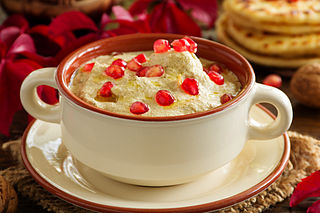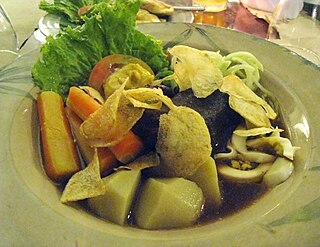Related Research Articles

Scotch bonnet is a variety of chili pepper named for its supposed resemblance to a Scottish tam o' shanter bonnet. It is ubiquitous in West Africa as well as the Caribbean. Like the closely related habanero, Scotch bonnets have a heat rating of 100,000–350,000 Scoville units. For comparison, most jalapeño peppers have a heat rating of 2,500 to 8,000 on the Scoville scale. However, completely sweet varieties of Scotch bonnet called cachucha peppers are grown on some of the Caribbean islands.

The cuisine of Senegal is a West African cuisine that derives from the nation's many ethnic groups, the largest being the Wolof. Islam, which first embraced the region in the 11th century, also plays a role in the cuisine. Senegal was a colony of France until 1960. From the time of its colonization, emigrants have brought Senegalese cuisine to many other regions.

Beef tongue is a cut of beef made of the tongue of a cow. It can be boiled, pickled, roasted or braised in sauce. It is found in many national cuisines, and is used for taco fillings in Mexico and for open-faced sandwiches in the United States. In France and Belgium it is served with Madeira sauce, while chrain is the preferred accompaniment in Ashkenazi and Eastern European cuisines. Germans make white roux with vinegar and capers, or horseradish cream, which is also popular in Polish cuisine.

Peanut stew or groundnut stew, also known as maafe, sauce d'arachide (French) or tigadèguèna is a stew that is a staple food in Western Africa. It originates from the Mandinka and Bambara people of Mali.

Siomay, is an Indonesian steamed fish dumpling with vegetables served in peanut sauce. It is derived from the Chinese Shumai. It is considered a light meal, similar to the Chinese Dim Sum. It is traditionally made from pork but is frequently substituted with tenggiri, as many Indonesians observe the halal dietary law. Sometimes other types of seafood such as tuna, mackerel, and prawn also can be used to make siomay. Other complements to siomay include steamed cabbage, potatoes, bitter gourd, boiled egg, and tofu. Siomay is often cut into bite size pieces and topped with peanut sauce, sweet soy sauce, chili sauce and a dash of lime juice.

West African cuisine encompasses a diverse range of foods that are split between its 16 countries. In West Africa, many families grow and raise their own food, and within each there is a division of labor. Indigenous foods consist of a number of plant species and animals, and are important to those whose lifestyle depends on farming and hunting.

Burkinabé cuisine, the cuisine of Burkina Faso, is similar to the cuisines in many parts of West Africa, and is based on staple foods of sorghum, millet, rice, fonio, maize, peanuts, potatoes, beans, yams and okra. Rice, maize and millet are the most commonly eaten grains. Grilled meat is common, particularly mutton, goat, beef and fish.

Satsivi is a Georgian dish. It is made using poultry mixed into a walnut sauce, typically seasoned with salt, pepper, garlic, fenugreek, coriander and cinnamon. The term satsivi is also used as a generic name for a variety of poultry made with the walnut sauce.

Tiep or thieb is a traditional dish from Senegambia that is also consumed in Guinea Bissau, Guinea, Mali and Mauritania. It is the national dish in Senegal. The version of tiep called thieboudienne or chebu jen is prepared with fish, broken rice and tomato sauce cooked in one pot. There are also tiep yappa and tiep ganaar. Additional ingredients often include onions, carrots, cabbage, cassava, hot pepper, lime and peanut oil, and stock cubes.

Bolognese sauce is a meat-based sauce in Italian cuisine, typical of the city of Bologna. It is customarily used to dress tagliatelle al ragù and to prepare lasagne alla bolognese.

Togolese cuisine is the cuisine of the Togolese Republic, a country in Western Africa. Staple foods in Togolese cuisine include maize, rice, millet, cassava, yam, plantain and beans. Maize is the most commonly consumed food in the Togolese Republic. Fish is a significant source of protein. People in Togo tend to eat at home, but there are also restaurants and food stalls.

Guinean cuisine includes the traditional dishes of fou fou, boiled mango, fried plantains, patates and pumpkin pie.

The cuisine of Mauritania includes the culinary practices of Mauritania. Historically, what is now Mauritania has been influenced by Arab, Berbers and African peoples who have lived in and traversed the "stark" landscape marked with Sahara desert dunes in caravans. There is an overlap with Moroccan cuisine in the north and Senegalese cuisine in the south.

Selat solo is a Javanese dish influenced by Western cuisine; it is a specialty of Solo city, Central Java, Indonesia. It consists of braised beef tenderloin served in thin watery sauce made from a mixture of garlic, vinegar, kecap manis, Worcestershire sauce, water, and spiced with nutmeg and black pepper. It is served with hard boiled egg and vegetables such as string beans, potato, tomato, lettuce, cucumber, cauliflower or broccoli and carrot, and topped with potato chips and some dash of mustard, hollandaise or sauce gribiche on the side.

Crab in oyster sauce or oyster sauce crab is a Chinese seafood dish of crab served in savoury oyster sauce. It is a popular dish in Asia, that can be found from China, Indonesia, Singapore to the Philippines.

Chinese bhel is a fast food and street food item in India and is considered a part of Indo-Chinese cuisine. It is a variant of chop suey and bhelpuri. It is popular in Mumbai.

Ifumi is an Indonesian crispy deep fried thick noodle dish, popular in Maritime Southeast Asia, served in a thick savoury sauce with pieces of meat or seafood and vegetables. The dishes are to be served hot while the noodles are still crisp until the noodles are softened by the sauce and are ready to be eaten. The dish is one of the most popular noodle dishes in Chinese Indonesian cuisine. The type of noodle being used in this dish is the thick yi mein noodle, hence the origin of its name. It is quite similar to mie kering noodles from Makassar.

Almadroc is a garlic-cheese sauce from medieval Catalan cuisine from the Llibre de Sent Soví. There is a similar recipe in the Llibre del Coch by Rupert de Nola for almadrote, a similar recipe for a sauce made with garlic, eggs, cheese and broth that was served with partridge. In modern usage it refers to an oil, garlic and cheese sauce served with eggplant casserole. Almadrote may have pre-Inquisition Sephardic origins and served with eggplant has become widespread in modern Turkish cuisine.
References
- ↑ "Footi Sauce à la Nene Galle Diallo Recipe from Senegal". Celtnet Recipes. Archived from the original on April 4, 2015. Retrieved December 24, 2023.